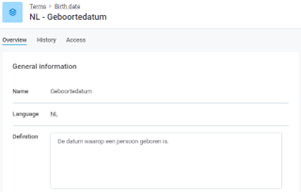Hi Community,
The previous posts about the business glossary dealt about applying more term types (attribute and entity terms), and how they get context by adding relationship types.
This time I want to discuss options to add multilingualism to the glossary. I don’t mean the One Web interface itself, but the content. When your company operates in an international environment, having term names and definitions in just one language may not suffice (although many people understand English, the level of understanding may vary, so translations will contribute to a better understanding of the glossary content).
So suppose the glossary contains content in English and, like in my situation, also Dutch translations are required for the term’s name and definition.
The most simple solution would be to add properties like nameDutch and businessDefinitionDutch to entity term. And when German translations are required as well, add properties nameGerman and businessDefinitionGerman and so on.
The pro of this approach is that it is very easy to implement. Cons are that for each new language you will need a new change to the term entity and the term’s screen layout will become more and more unclear.
Another solution, to be described in this article, has the opposite pros and cons.
So the requirements are a generic implementation of multilingualism, so allowing new languages without changing the metadata model, and keeping the interface as clean as possible. As follows.
Because of the generic-implementation requirement somehow the translations must end up in a new metadata entity, with properties that will contain the actual translations. Translations will apply to all of our term types, so attribute, entity and business terms, so a relation to the new translations entity will be defined in entity term. The translations will only exist in the context of its original term, so from entity term we will define an embedded array of translations. So when a term is deleted, also its translations will be deleted along with it.
So implement the translation details in a new entity, for instance termTranslation, with properties name, definition and language. Property language is a reference to (also new) entity language, with properties language and languageCode. Note that I did not use a name property in the language entity. This name property is actually expected in each entity. Without it, in the interface the GID of an occurrence of the entity will be shown. To ‘correct’ this you can use entity trait core:displayName, with property {"propertyName": "languageCode"}. So now the languageCode property will act as name property. In conclusion the extension of the model is as follows.

Our implementation of multilingualism looks as follows in OneWeb.

and

Note that on the main screen in the Translations section a concatenation of the language code and translated term name is shown.
How that can be accomplished will be the subject of the next article.
Kind regards,
Albert







